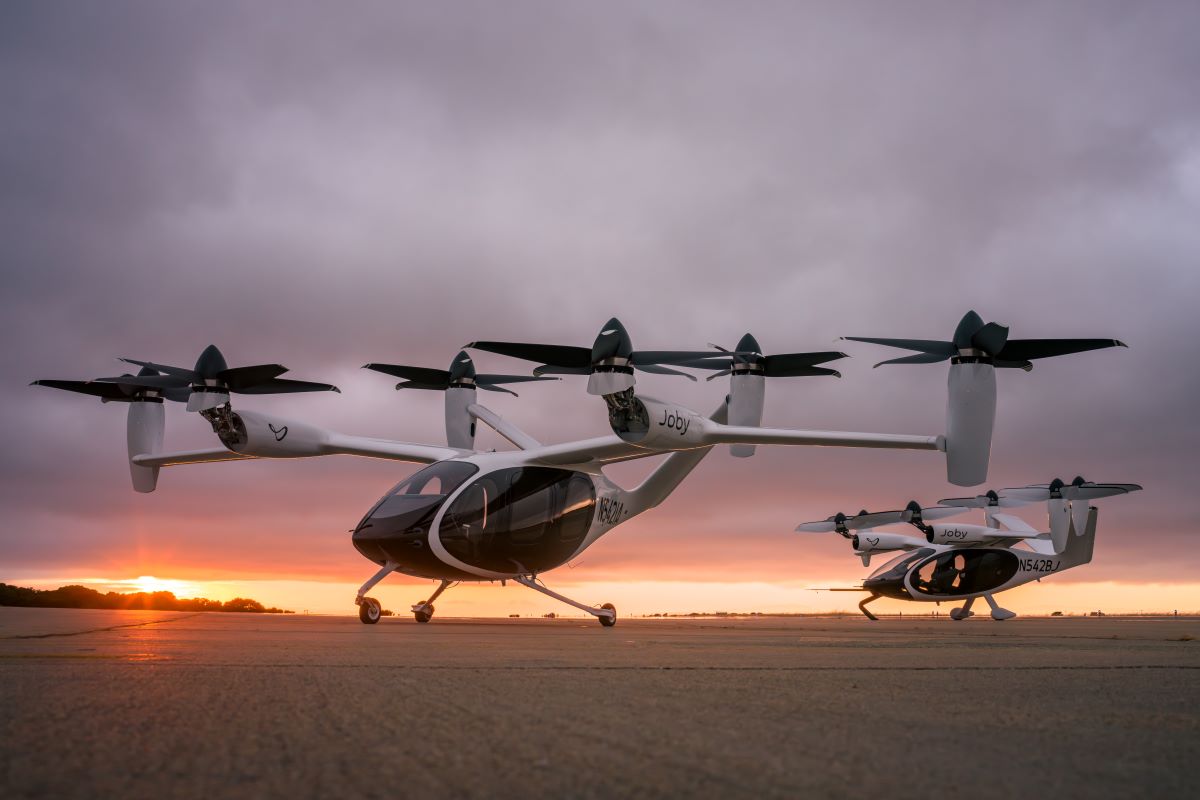This article is a part of a series of profiles of CalChamber member companies that are contributing to the state’s economic strength and ability to stay competitive in a global economy. Visit California Works to learn more about this series and read past and future profiles.
 The building blocks to achieve production must come together concurrently with type certification, if an aircraft manufacturer has any hope of launching a new product in a timely fashion.
The building blocks to achieve production must come together concurrently with type certification, if an aircraft manufacturer has any hope of launching a new product in a timely fashion.
To this end, Joby Aviation has been formulating its processes along with the tooling, hardware, software, and teams required to achieve the goal of eVTOL success.
On Wednesday [June 21], Joby revealed a major milestone in the road to a type certificated production aircraft with the rollout of its first model built on the company’s Pilot Production Facility’s final assembly line in Marina, California. Derived from released engineering drawings under the OEM’s purpose-built quality management system, the production prototype makes for a “major step” on the road to aircraft manufacturing at the scale that Joby projects in both its short- and long-term plans.
In the Wednesday event with longtime partner — and largest investor — Toyota, and a visit from California Governor Gavin Newsom, Joby displayed the latest version of the eVTOL [electric vertical take off and landing]. It marks a first in the industry, too, to have a production prototype out the door, complete with the special airworthiness certificate to start flying it.

“Today’s achievement is the culmination of years of investment in our processes and technology and it marks a major step on our journey to scaled production,” said JoeBen Bevirt, founder and CEO of Joby.
“We’re proud to have launched production in our home state of California. I’m incredibly grateful to the Joby team for their commitment to ensuring Joby remains the clear leader in this new sector and to Toyota for sharing their knowledge and experience with us over many years. Their support has been indispensable in helping us reach this point.”
Newsom said: “California is proud to be home to some of the world’s most innovative companies. Joby is changing the game when it comes to the next frontier of flight: zero emission aviation. Our world-leading climate action relies on the technological advances and pioneering spirit of the private sector. Creating jobs and cutting pollution — that’s the California way.”
Full Scale to Full Scale
Joby began flying a subscale demonstrator in 2014 — and it has been flying full-scale prototypes for six years now. In fact, flights of the preproduction prototype have become a regular sight at the Marina Municipal Airport (KOAR), where the last stages of assembly take place.
After an initial flight test program, Joby will deliver the aircraft to Edwards Air Force Base, where it will fulfill part of the company’s $131 million contract with the U.S. Air Force. If this beats other eVTOL manufacturers to the punch, it will mark the first customer delivery in the industry.
Toyota Motor CEO Joins the Board
Toyota has been an intimate partner to Joby, assisting with the design of the production line and facility, with Toyota personnel embedded in Joby teams during the development and production of the prototype aircraft. Tetsuo “Ted” Ogawa, president and CEO of Toyota Motor North America Inc., joined more than 1,000 guests and team members at Joby’s Marina facility to celebrate the launch of production.
Ogawa will also join Joby’s board of directors on Saturday [July 1]. “We congratulate Joby on reaching this milestone and look forward to working ever more closely as Joby prepares to scale production and start operations,” he said.
Joby Attracts $100 Million Investment
On Thursday [June 22], the company announced a deepening of its partnership with South Korea telecommunications giant SK Telecom with its $100 million equity investment. The agreement was executed on June 27, and comes as part of Joby’s planned participation in the country’s S-UAM Grand Challenge alongside SKT. The challenge will help South Korea develop its nascent aerial ridesharing program.
Range, Speed
Joby also unveiled more data on its production conforming prototype, giving range and speed figures, along with details on the battery and power systems as notches this progress with the final configuration. With dual-wound motors and isolated battery packs, the propulsion system and its energy storage system offer multiple levels of redundancy and no single point of failure.
The model’s peak power delivers “nearly twice the power of the Tesla Model S Plaid, despite being lighter,” according to the company, and its peak torque is roughly commensurate with that of a Ford F-350 heavy duty truck.
Pouch cells sourced from the automotive supply chain offer the right cell-specific energy needed to deliver on “key metrics,” said Joby in a presentation with the event. And at the pack level, the specific energy provided also conforms to the standard required — and meets the FAA’s safety strictures while still giving “industry-leading performance.”
Joby expects the aircraft to recharge quickly, in “the time it takes to deplane and load passengers on more than 95 percent of the trips taken today in our target markets.”
Joby’s New Prototype, By the Numbers
- Payload: 1,000 pounds
- Capacity: 1 pilot, 4 passengers
- Range: up to 100 miles (87 nm)
- Cruise Speed: up to 200 mph (174 knots)
- Noise Footprint: 45 dBA in cruise
- Peak Power: 236 kW
- Weight of Dual-Wound Motor Plus Inverter: 28 kg
- Peak Torque: 1,800 N m
- Continuous Torque: 1,380 N m
- Cell-Level Specific Energy: 288 Wh/kg
- Flight Cycles: 10,000 plus
- Pack-Level Specific Energy: 235 Wh/kg
Joby Aviation and Toyota Motor are members of the California Chamber of Commerce. This article by Julie Boatman was first published on flyingmag.com.

